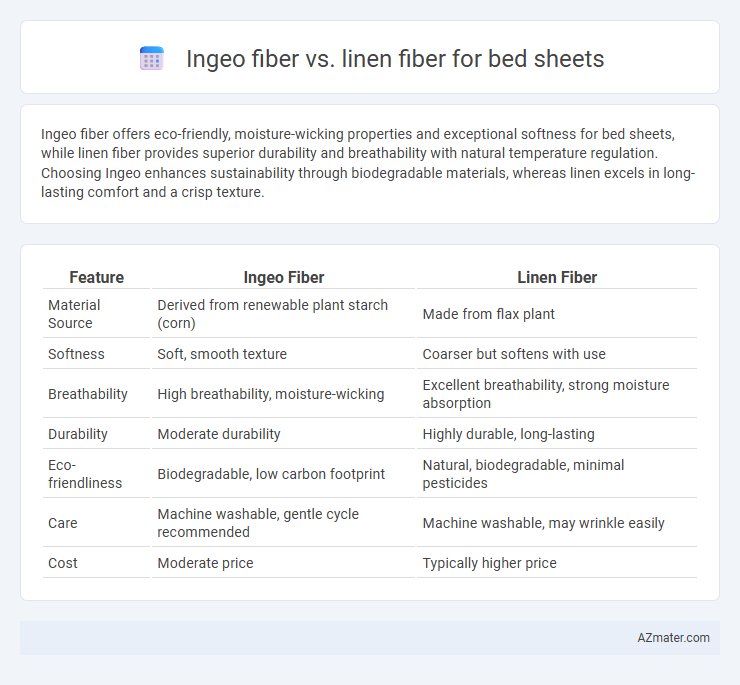Ingeo fiber offers eco-friendly, moisture-wicking properties and exceptional softness for bed sheets, while linen fiber provides superior durability and breathability with natural temperature regulation. Choosing Ingeo enhances sustainability through biodegradable materials, whereas linen excels in long-lasting comfort and a crisp texture.
Table of Comparison
| Feature | Ingeo Fiber | Linen Fiber |
|---|---|---|
| Material Source | Derived from renewable plant starch (corn) | Made from flax plant |
| Softness | Soft, smooth texture | Coarser but softens with use |
| Breathability | High breathability, moisture-wicking | Excellent breathability, strong moisture absorption |
| Durability | Moderate durability | Highly durable, long-lasting |
| Eco-friendliness | Biodegradable, low carbon footprint | Natural, biodegradable, minimal pesticides |
| Care | Machine washable, gentle cycle recommended | Machine washable, may wrinkle easily |
| Cost | Moderate price | Typically higher price |
Introduction to Ingeo Fiber and Linen Fiber
Ingeo fiber, derived from renewable plant-based sugars through a fermentation process, offers a sustainable and biodegradable option for bed sheets with a soft, breathable texture and natural moisture-wicking properties. Linen fiber, sourced from the flax plant, is renowned for its exceptional durability, breathability, and inherent antibacterial qualities, providing a cool and comfortable sleep experience. Both fibers emphasize eco-friendliness and comfort, but Ingeo's innovative bio-based origin contrasts with linen's traditional natural fiber heritage.
Origins and Production Process
Ingeo fiber is derived from renewable plant-based materials, primarily corn starch, through a fermentation process that converts sugars into polylactic acid (PLA) biopolymer, making it a sustainable alternative to traditional fibers. Linen fiber originates from the flax plant, where the fibers are extracted through retting, drying, and scutching processes before being spun into yarn, representing a natural and historically traditional textile source. The production of Ingeo is energy-efficient with lower greenhouse gas emissions, while linen involves labor-intensive manual processes but results in durable, breathable fabric well-suited for bed sheets.
Environmental Sustainability Comparison
Ingeo fiber, derived from renewable corn starch, offers a lower carbon footprint and biodegradability compared to traditional linen fiber, which is made from flax plants requiring significant water and pesticide use. Ingeo production emits fewer greenhouse gases and consumes less energy, enhancing its appeal for eco-conscious bedding. Linen fibers, while natural and durable, have a longer cultivation period and higher environmental impact, making Ingeo a more sustainable choice for bed sheets.
Comfort and Softness Analysis
Ingeo fiber, derived from renewable plant-based materials, offers a smooth, silky texture that enhances breathability and moisture-wicking properties, making it exceptionally comfortable for bed sheets. Linen fiber, known for its natural strength and durability, provides a distinctive crispness that softens with use, delivering a cool and breathable sleep experience. While Ingeo excels in smoothness and moisture management, Linen stands out for its textured comfort and long-term softness, offering distinct advantages depending on personal preference.
Moisture Wicking and Breathability
Ingeo fiber, derived from renewable plant-based sources, offers superior moisture-wicking properties by efficiently drawing sweat away from the skin, keeping sleepers dry and comfortable throughout the night. Linen fiber, made from flax plants, is highly breathable due to its natural fiber structure, allowing excellent airflow and temperature regulation, which is ideal for hot climates. While both fibers excel in moisture management, Ingeo's advanced moisture-wicking ability provides enhanced dryness, whereas linen's open weave enhances breathability and cooling effects.
Durability and Longevity
Ingeo fiber, derived from renewable plant materials, offers strong resistance to wear and tear, making it a durable choice for bed sheets that maintain integrity over time. Linen fiber, known for its natural strength and moisture-wicking properties, provides exceptional longevity with increased softness after each wash. Both fibers excel in durability, but Ingeo's resilience against environmental stress and linen's enduring fabric quality ensure long-lasting bedding performance.
Hypoallergenic and Skin-Friendliness
Ingeo fiber, made from natural plant-based materials, offers excellent hypoallergenic properties that resist dust mites and mold, making it ideal for sensitive skin and allergy sufferers. Linen fiber, derived from flax plants, is naturally breathable and moisture-wicking but can feel rougher on the skin compared to the smooth, silky texture of Ingeo fiber. Both fibers are eco-friendly, but Ingeo fiber stands out for its superior softness and skin-friendliness, enhancing comfort in bed sheets for those with sensitive or allergy-prone skin.
Maintenance and Care Requirements
Ingeo fiber bed sheets require minimal maintenance, as they are resistant to wrinkles, shrinking, and stains, allowing for easy machine washing at lower temperatures without fabric damage. Linen fiber bed sheets need careful handling, often requiring gentle washing, air drying, and occasional ironing to maintain their durability and natural texture. Ingeo's easy-care properties make it ideal for those seeking low-effort bedding, while linen offers high breathability and a unique feel with a more demanding care routine.
Cost and Market Availability
Ingeo fiber bed sheets typically cost more than linen due to the advanced biopolymer production processes involved, while linen sheets offer a more affordable option with widespread availability in home textile markets. Linen fibers are derived from flax plants, providing natural breathability and durability, making them popular in regions with established flax cultivation and textile manufacturing. Ingeo fiber, a trademarked brand of polylactic acid (PLA), is less common but gaining traction in eco-friendly bedding segments, available mainly through specialty retailers focused on sustainable products.
Final Verdict: Which Fiber is Better for Bed Sheets?
Ingeo fiber, derived from corn starch, offers excellent moisture-wicking properties and sustainability benefits, making it a breathable and eco-friendly choice for bed sheets. Linen fiber, made from flax plant, boasts superior durability, natural temperature regulation, and a luxurious texture that improves with age. For durability and a natural feel, linen is preferable, while Ingeo is ideal for those prioritizing softness and environmental impact in their bedding.

Infographic: Ingeo fiber vs Linen fiber for Bed sheet
 azmater.com
azmater.com